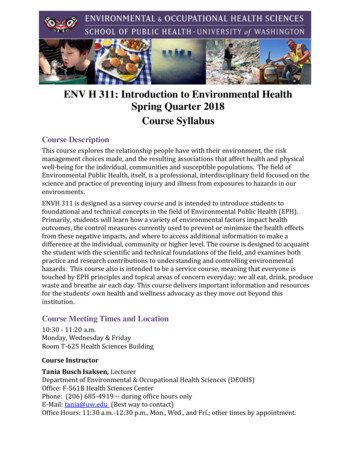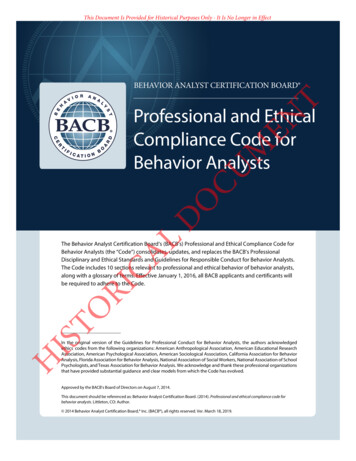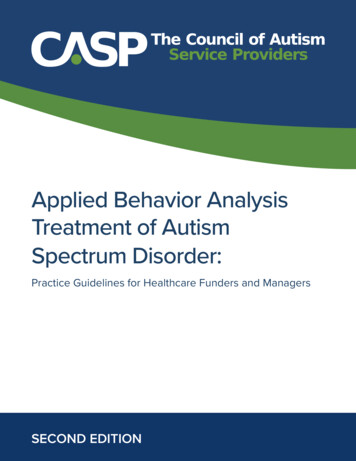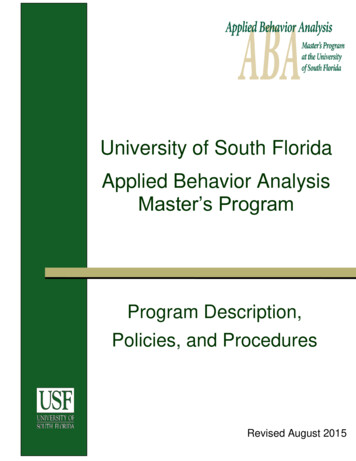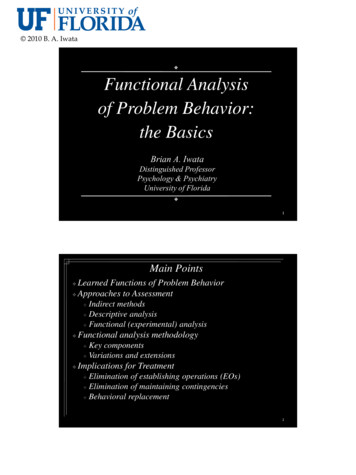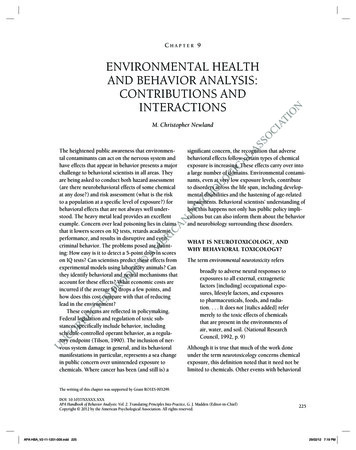
Transcription
Chapter 9Environmental Healthand Behavior Analysis:Contributions andInteractionsM. Christopher NewlandThe heightened public awareness that environmental contaminants can act on the nervous system andhave effects that appear in behavior presents a majorchallenge to behavioral scientists in all areas. Theyare being asked to conduct both hazard assessment(are there neurobehavioral effects of some chemicalat any dose?) and risk assessment (what is the riskto a population at a specific level of exposure?) forbehavioral effects that are not always well understood. The heavy metal lead provides an excellentexample. Concern over lead poisoning lies in claimsthat it lowers scores on IQ tests, retards academicperformance, and results in disruptive and evencriminal behavior. The problems posed are daunting: How easy is it to detect a 5-point drop in scoreson IQ tests? Can scientists predict these effects fromexperimental models using laboratory animals? Canthey identify behavioral and neural mechanisms thataccount for these effects? What economic costs areincurred if the average IQ drops a few points, andhow does this cost compare with that of reducinglead in the environment?These concerns are reflected in policymaking.Federal legislation and regulation of toxic substances specifically include behavior, includingschedule-controlled operant behavior, as a regulatory endpoint (Tilson, 1990). The inclusion of nervous system damage in general, and its behavioralmanifestations in particular, represents a sea changein public concern over unintended exposure tochemicals. Where cancer has been (and still is) asignificant concern, the recognition that adversebehavioral effects follow certain types of chemicalexposure is increasing. These effects carry over intoa large number of domains. Environmental contaminants, even at very low exposure levels, contributeto disorders across the life span, including developmental disabilities and the hastening of age-relatedimpairments. Behavioral scientists’ understanding ofhow this happens not only has public policy implications but can also inform them about the behaviorand neurobiology surrounding these disorders.What is Neurotoxicology, andWhy Behavioral Toxicology?The term environmental neurotoxicity refersbroadly to adverse neural responses toexposures to all external, extrageneticfactors [including] occupational exposures, lifestyle factors, and exposuresto pharmaceuticals, foods, and radiation. . . . It does not [italics added] refermerely to the toxic effects of chemicalsthat are present in the environments ofair, water, and soil. (National ResearchCouncil, 1992, p. 9)Although it is true that much of the work doneunder the term neurotoxicology concerns chemicalexposure, this definition noted that it need not belimited to chemicals. Other events with behavioralThe writing of this chapter was supported by Grant RO1ES 003299.DOI: 10.1037/XXXXX.XXXAPA Handbook of Behavior Analysis: Vol. 2. Translating Principles Into Practice, G. J. Madden (Editor-in-Chief)Copyright 2012 by the American Psychological Association. All rights reserved.APA-HBA V2-11-1201-009.indd 22522529/02/12 7:19 PM
M. Christopher Newlandconsequences could fall under this definition,including closed head injuries, significant stressorsor other traumas, or drug exposures. Behavioral scientists’ knowledge of how to examine environmental neurotoxicants could certainly be appliedusefully in these other areas.Why behavioral toxicology? Just as “nothing inthe nervous system makes sense except in light ofbehavior” (Shepard, 1994, p. 9), one can argue thatnothing in neurotoxicology matters until behavioralconsequences occur. Tiny changes in the processesof neurotransmission or the course of developmentdo not raise concern until they are manifested inbehavior. The important role played by behavior isseen not only in neurotoxicology but also in theneurosciences. Psychology, including the study ofbehavior, has been listed as one of the pillars of neuroscience, along with anatomy, physiology, pharmacology, and embryology (Kandel, 1991).Behavioral toxicology, then, is the study of thebehavioral expression of neurotoxic events. Thecore assumptions are that behavior is orderly andcan be brought into the laboratory for study and thatwhat occurs in the laboratory corresponds to what isseen in people. Insofar as neurotoxic effects becomeimportant when seen in behavior, behavior can beviewed as the way to answer the so-what questionsthat are inevitably posed about subtle changesreported by other disciplines.The presence of psychological, neural, and publichealth sciences is part of what makes neurotoxicology so interesting. This area exemplifies an arena inwhich behavior analysis participates in an interdisciplinary attempt to understand the many determinants of behavior. Clues about neural and behavioralmechanisms of action derive from observations that,for example, a compound results in perseveration inbehavior, disrupts dopamine in selected regions ofthe nervous system, and damages laminated structures like the frontal cortex and cerebellum, as doesmethylmercury (described in the Mechanisms andInterventions section later in this chapter).Behavior analysts can benefit from this participation by learning more about influences on behavioror, as described later in the Human Testing section,links between conditioning principles and the sortsof behavior tapped by neuropsychological testing.Another tactic that behavior analysts might learn isthe extrapolation from small-scale studies to broaderconclusions about public health. Many in behavioranalysis are quite accustomed to small-N experimental design, but many discoveries in behavior analysismust be confirmed or applied on a much largerscale. The ability to scale up investigations will bekey to the long-term impact of behavior analysis,and some ideas for doing so can be drawn fromenvironmental neurobehavioral toxicology (see theAssessment of Risk section).Scope of the ProblemIn 1984, the National Research Council estimatedthat more than 65,000 chemicals were in production. Barely any information was available on theoverwhelming majority of these chemicals, eventhose whose structure suggested significant potentialfor toxicity and that were high priority, that is, usedin commerce at a rate exceeding 1 million pounds(500 tons) per year. About 12 years later, the Environmental Protection Agency concluded that therewere about 15,000 new chemicals but, as noted bythe Environmental Defense Fund, the understandingof them has not improved (Roe, Pease, Florini, &Silbergeld, 1997). Even among high-priority chemicals, the problem of toxic ignorance is severe. Ofthese chemicals, only 33% have undergone any neurotoxicity testing, and 10% have undergone testingfor developmental neurotoxicity (Roe et al., 1997).How many are neurotoxic? How many accelerateaging or disrupt development? We do not know, butwe do know what kinds of problems these chemicalsmight cause. About 10% of boys in the U.S. population are estimated to have attention deficit/hyperactivity disorder, and many of these cases can be linkedto environmental contaminants (Visser & Lesesne,2005). Between 3% and 25% of cases of attention deficit/hyperactivity disorder have been attributed toenvironmental contaminants alone or in combinationwith parenting, drug use, or other lifestyle factors(Landrigan, Kimmel, Correa, & Eskenazi, 2004).(When gasoline was leaded, this number would havebeen much higher.) The costs of these effects are difficult to estimate, but they are certainly large (Koger,Schettler, & Weiss, 2005). The economic benefits of226APA-HBA V2-11-1201-009.indd 22629/02/12 7:19 PM
Environmental Health and Behavior Analysisattending to environmental causes of behavioral deficits can be seen in recent estimates of the impact ofremoving lead from gasoline. This single act has beenestimated to have resulted in a halving of violentcrime (Reyes, 2007) and of the number of individuals eligible for a diagnosis of mental retardation(Nevin, 2009), and many have argued that furtheraction may have even greater benefits (Gilbert &Weiss, 2006). The addition of lead to gasoline in the1930s imposed a massive societal cost, one that wasdifficult to detect in comparison with chemicals thatcause functional deformities or cancer.The ChallengeBehavioral toxicology has sometimes been viewed,somewhat derisively, as “high-dose pharmacology.”In fact, the opposite is true, at least with respect toenvironmental neurotoxicants, which is why thedesign of behavioral procedures that are sensitiveand informative is both challenging and important.Figure 9.1, from a symposium on the future of neurotoxicology (Weiss et al., 2008), illustrates theissue of dose. The top panel shows an idealizedquantal dose–response relationship that might arisefrom a laboratory study. Two effects are shown: asubtle effect (e.g., the proportion of animals whoselever-press rates declined) and a more severe effect(e.g., severe, overt effects or even death).Sensitivity varies across individuals, with a portion of the sample showing effects at a dose of 20units (e.g., 20 micrograms per kilogram per day)and others showing no effect until the dose exceeds80 units. Subtle effects occur at lower doses thansevere effects, but in this example at least, the rightend of the curve showing subtle effects overlapswith the left end of the curve that shows overtpathology or death: A dose of 100 or so is barelyeffective for some, but highly toxic for others.Now consider the experimental design problemin determining the leftmost open data point, adose that affects 5% of the sample population. Following a rule of thumb that at least five cases arerequired to detect such a data point, one wouldneed 5/.05 100 subjects to detect effects in thesesensitive individuals. Rarely, however, will oneknow when designing a study which combination ofFigure 9.1. A dose–response relationship showingpercentage of the population affected on the verticalaxis, seen from a laboratory (top) or an environmental(bottom) perspective. Reprinted from NeuroToxicology,29, B. Weiss, D. Cory-Slechta, S. G. Gilbert, D.Mergler, E. Miller, C. Miller, . . . T. Schettler, “TheNew Tapestry of Risk Assessment,” pp. 883–890.Copyright 2008, with permission from Elsevier.variables (e.g., dose, gender, age, strain) will contribute to individual susceptibility. Detecting sucha level can lead to very large and complex studydesigns, as illustrated in the ED01 study, designedto detect the dose that caused cancer in 1% of theexperimental group and that required many thousands of subjects to do so (Gaylor, 1980).However, a dose that causes a large effect in5% of the population could be a national disaster.227APA-HBA V2-11-1201-009.indd 22729/02/12 7:19 PM
M. Christopher NewlandEnvironmental exposures are typically well belowthose used in the laboratory, as illustrated in thebottom panel, in which the top dose–response relationships are replotted against what may be environmentally relevant exposures that lie to the left ofthose usually studied in the laboratory.The best solution is to use behavioral measuresthat are sensitive and that reflect effects seen inexposed populations. That is where behavior analysis has played an especially important role. Byexploiting the law of effect, behavior analysts cangain control over variability across subjects andwithin subjects and design highly sensitive preparations and measures that reflect either integrated nervous system activity or specific neural processes.This control enhances experimental and statisticalpower to detect important effects.A second solution, implemented in tandem withthe development of sensitive measures, is low-doseextrapolation, in which a structured estimate (i.e.,an educated guess) is generated to estimate whatoccurs at environmentally relevant exposures. Biostatistics, using data from experimental models andepidemiological investigations, plays a large rolehere (described in the Assessment of Risk section).A third, untenable solution is to give up and say thatscientists cannot deal with such low exposure levelsbecause they lead them too far from the data. Thisapproach, which ignores valuable quantitative information that is available, has led to such “solutions”as the Delaney clause (a 1958 amendment to theFood, Drugs, and Cosmetic Act of 1938) that forbade any chemical that caused cancer at any dosefrom entering the marketplace. Such an approachwould be a nightmare if applied to neurotoxicitybecause some doses will often have a behavioraleffect. This approach has been criticized because itimposes large barriers to the development of saferchemicals, such as pesticides, while leaving older,unsafe ones “grandfathered” into approved use(O’Donoghue, 1994).Conditioned and UnconditionedBehaviorOne question that sometimes arises is, “What dowe mean by behavior?” A useful definition can bedifficult to come by, but a functional classification ofbehavior is helpful. One approach is to distinguishbetween conditioned and unconditioned behavior.Conditioned behavior typically refers to respondingthat has been brought under the control of Pavlovian or operant conditioning. This takes time but alsorefines behavior, reduces variability, and helps toidentify important influences. Unconditioned behav ior might be viewed as anything else and can includespontaneous locomotor activity or even elementaryforms of learning such as habituation. Becauseobservations of unconditioned behavior can beaccomplished quickly, such behavior can be helpfulin the early stages of an investigation or, for example, the identification of a range of effective doses.Screening Versus Advanced ApplicationsThere are two classes of approaches to behavioraltesting. The first entails systematic screening techniques such as the Functional Observational Battery(Moser, 1989). These techniques permit a rapidassessment of the range of doses that are likely to beactive and the functional domains (sensory, motor,central, peripheral, autonomic, etc.) that might be atrisk (see also Vorhees, 1987). The proceduresinvolve spending a small amount of time with anyone animal and can be conducted with minimalinvestment in equipment or (animal) training time.They can be labor intensive and relatively insensitive to subtle effects, and sometimes they requiresubjective judgment because the results may showhigh levels of variability.The second class, advanced applications, permitsthe examination of behavioral and neural mechanisms of action that may be especially sensitive tolow exposure levels and careful description of sensory, motor, or cognitive effects. These designs frequently apply reflexive, Pavlovian, or operantconditioning techniques to develop a specializedbehavioral preparation. Reflexive techniques,including sensitization, habituation, and prepulseinhibition (the reduction of acoustic startle by thedelivery of a faint tone immediately preceding theonset of a startle tone), have helped to describeototoxicity (Crofton, 1990; J. S. Young & Fechter,1983). More advanced conditioning techniques areflexible, sensitive, and highly informative, but they228APA-HBA V2-11-1201-009.indd 22829/02/12 7:19 PM
Environmental Health and Behavior Analysisoften require extensive animal training time (especially approaches using operant behavior), equipment and software investments, and sophisticatedinvestigators.Investments in developing advanced applicationsresult in significant returns in sensitivity, quality control, specificity, and with respect to basic research,advancing scientists’ understanding of behavior.Consider a widely used procedure such as the fixedinterval (FI) schedule of reinforcement. Under thisstraightforward procedure, a reinforcer (usually asmall bit of food) is delivered after the first responseto occur after some fixed amount of time has passed.Thus, under a fixed-interval (FI) 2-minute schedule,the first response after 2 minutes has passed results inreinforcement. A predictable response pattern occurs:low responding early in the interval and a progressively increasing rate as the interval times out. Thisprocedure is an example of schedule-controlled operant behavior, mentioned previously.An extensive literature on FI schedules of reinforcement can be found in the basic experimentalanalysis of behavior and the behavioral pharmacology literatures. Therefore, behavioral scientistsknow what kind of behavioral pattern to expectwhen this procedure is implemented appropriately(Zeiler, 1977). They also know about the sensitivityof the FI schedule to drug exposures and what patterns of behavior a class of drugs is likely to produce (Branch, 1984, 1991; Kelleher & Morse, 1968).Building on such orderliness yields quantifiablebehavioral measures, a consistent pattern acrosssettings and species, and known sensitivity todrugs and chemicals (Newland, Pennypacker,Anger, & Mele, 2003). Successful transfer of technology is more likely when important characteristics of the product can be quantified, when theconditions required for its reproduction can beclearly identified, and when its successful reproduction can be verified (Pennypacker, 1986). Thisis certainly true of procedures built on conditioning principles. For the FI schedule, for example,measures of response rate and temporal patternscan be examined as quality control measures toensure that the procedure has been appropriatelyimplemented.Operant BehaviorOperant behavior, which includes what is commonly referred to as voluntary behavior, involves athree-term operant contingency of reinforcement(antecedent stimuli, response, consequence).Briefly, a response is an operant if its consequencechanges its subsequent likelihood of reoccurrencein the same or a similar context. The context can bepresent at the time of the response (discriminationor generalization, e.g.), or it may have occurred inthe immediate or distant past (remembering). Theelements of the three-term contingency do not existin isolation, but the role of different elements canbe emphasized to refine the behavioral procedure.Figure 9.2 illustrates how this understanding of theFigure 9.2. A schematic representation showing the threeterm operant contingency (right) and how a focus on selected elements might be applied in behavioral evaluations (left).229APA-HBA V2-11-1201-009.indd 22929/02/12 7:19 PM
M. Christopher Newlandelements of behavior can be applied in behavioraltoxicology.The operant. An operant may be a lever press,but a complex response pattern can itself be placedunder a reinforcement contingency. The study ofmotor function often entails gaining control overprecise physical characteristics of the operant, suchas its position, the force with which it is executed,its speed, or its duration. These physical dimensions of the operant can be manipulated if oneunderstands the principles of reinforcement. Fowler,McKerchar, and Zarcone (2005) have examinedforce, rhythmicity, and precision of forelimb forcesand tongue movements in rodents. In the waterfountain task, rats press with a predefined force on asmall disk while licking from a water dispenser thatis activated by the application of force. By exertingprecise control over the force exerted by the forelimb, this task makes it possible to detect tremor,dystonias, or extrapyramidal effects of neurolepticdrugs and potentially other neurotoxicants.In the licking task, rats lick an apparatus thatmeasures the force, rate, and periodicity of licking.The task is appealing because it is simple to establish, is sensitive, and yields important informationabout neurobehavioral function quickly. For example, older rats lick at a slower rate than control rats,and this effect is associated with correlations amonglick rate, total licking, and dopamine content instriatal and nigral dopamine (Stanford, Vorontsova,Surgener, Gerhardt, & Fowler, 2003). In otherstudies, lick force has revealed strain differences anddistinguished between neuroleptics that act at D1versus D2 dopamine receptor systems (Wang &Fowler, 1999).Even higher order characteristics of operantbehavior can be investigated. For example, under asecond-order schedule of reinforcement (i.e., aschedule of a schedule), a complex response unit isitself placed under an overall schedule of reinforcement (Marr, 1979). Thus, a match to sample(Newland & Marr, 1985), a subordinate schedule(Marr, 1979), or the production of a response chain(Thompson & Moerschbaecher, 1978, 1979) can bereinforced under, for example, overarching FI orfixed-ratio (FR) schedules, and the rate and timingof the appearance of these complex units demonstrate schedule-typical patterns. Thus, second-orderschedules can be imposed to study how a complexoperant emerges or how its structure falls apart withrepeated exposures to neurotoxicants (Newland,1995, 1997).Antecedent stimuli. Discrimination processes perse can be sensitive indicators of neurotoxic exposure, but we use the testing of sensory systems asan example of the application of this componentof the three-term contingency. Sensory testing in averbally competent person is relatively straightforward: Ask whether someone can see the letter E ona Snellen chart or hear a tone through headphones,and increase or decrease the difficulty of the discrimination according to the answer. Doing so in anonhuman animal can be accomplished by bringingoperant responding under the control of an exteroceptive (external) antecedent stimulus so that thetraditional psychophysical techniques can be used(Maurissen, 1995; Rice, 1994). The animal is asked,for example, to produce one response in the presence of the stimulus and a second response in itsabsence. Somatosensory systems have been examined by detecting sensitivity to a vibrating stimulusapplied to the finger (Maurissen, 1990; Rice &Gilbert, 1995). Auditory sensitivity can be examinedby bringing behavior under the control of the presence or absence of a tone (Burbacher, Grant, Gilbert,& Rice, 1999; Pryor, Dickinson, Feeney, & Rebert,1984; Rice & Gilbert, 1992). Visual acuity, flickerfusion, contrast sensitivity contours (Burbacher,Grant, Mayfield, Gilbert, & Rice, 2005; Merigan,Wood, Zehl, & Eskin, 1988; Rice & Hayward,1999a), and pain (Weiss & Laties, 1970) have allbeen examined using operant techniques. Thestudy of pain is especially interesting because of thedevelopment of the tracking, or titration, procedure.Here, the animal’s responding controls the stimulusmagnitude, so there is no exposure to distressfulpain and pain can be studied ethically in individualanimals (Laties & Wood, 1984).Behavior can be brought under the control ofan interoceptive (private) stimulus, too. The aforementioned study of pain (Laties & Wood, 1984) isone example. Others can be drawn from the drug230APA-HBA V2-11-1201-009.indd 23029/02/12 7:19 PM
Environmental Health and Behavior Analysisdiscrimination literature (see Volume 1, Chapter 23,this handbook). Just as a response can be broughtunder the control of whether a light is on or off, sotoo can a response be brought under the control ofwhether, say, a drug or biologically inactive vehiclehas been delivered. Here, pressing the right levermay be reinforced after a presession drug injection,and pressing the left lever may be reinforced in different sessions after vehicle injections. Such procedures have provided solid behavioral evidence thatmany organic solvents share interoceptive stimulusproperties with sedative hypnotics such as oxazepam, ethanol, or pentobarbital (Rees, Knisely, Balster, Jordan, & Breen, 1987; Rees, Knisely, Breen, &Balster, 1987). These observations are supported byobservations at other levels of analysis. For example,oxazepam, ethanol, and pentobarbital all promoteactivity of the GABAA receptor. Drugs that act atother receptors produce different interoceptiveeffects, as reported in animal studies of drug discrimination procedures and by humans when askedto describe how they feel. Many subjective effectscan be examined using similar methods, includinghunger (Corwin, Woolverton, & Schuster, 1990),withdrawal from drugs (Emmett-Oglesby, Mathis,Moon, & Lal, 1990), or anxiety-like states (Leidenheimer & Schechter, 1988).More nuanced subjective characteristics of chemicals can be examined in humans by drawing on subjective effects questionnaires such as those used todetect subjective effects profiles in human drugusers (Preston & Bigelow, 1991). Environmental oroccupational neurotoxicants have been linked toself-reports of apathy, depression, excitability, hallucinations, irritability, nervous tension, fatigue, andrestlessness (Anger, 1986). Self-report measuressuch as the Profile of Mood States may providesensitive measures of low-level exposure whenpresented in an objective manner, as with testingbehaviorally active drugs. Measures such as these aresensitive to cultural differences and degree of education, so care must always be taken in interpretingsuch data (Anger et al., 2000; Rohlman et al., 2000).Two examples illustrate the use of subjectiveeffects questionnaires in behavioral toxicology.The first is the use of the Profile of Mood Statesin the study of manganese neurotoxicity. Whenmanganese is encountered at high exposure levels(e.g., in unsafe mining operations), it produces aneurological syndrome that includes significantmotor deficits (Barbeau, Inoue, & Cloutier, 1976;Couper, 1837) and locura manganica, which ischaracterized by mania, hypersexuality, and varioussubjective effects (Cotzias, 1958). Some of thesesubjective effects have been captured using the Profile of Mood States, which is similar to measuresused to document subjective effects of behaviorallyactive drugs. People exposed to manganese occupationally, and who also reported drinking more than400 grams of alcohol per week, reported a constellation of subjective states including anger, vigor, confusion, tension, depression, and fatigue (Bouchardet al., 2003). In a second example, also using theProfile of Mood States, an organic solvent, trichloroethylene, was reported to have effects that resembledthose of ethanol (Reif et al., 2003). In this case,exposure was low level and environmental becauseit occurred in drinking water as a result of contamination of a municipal water supply.Consequences. As noted earlier (and shown inFigure 9.2), the consequences of behavior influenceits future occurrence and establish the importance ofthe context in which behavior occurs. As with drugs(A. Young & Herling, 1986), toxic substances canserve as both reinforcing and aversive consequentevents. For example, in addition to being neurotoxic, some solvents also have significant abusepotential when exposure is voluntary (Wood, 1979).These compounds include toluene (the ingredientthat supports glue sniffing), gasoline, and inhalants.This reinforcing property of solvents increases thelikelihood that individuals will be exposed to them.Irritancy is also a toxic property that is readilyamenable to behavioral evaluation and quantification in laboratory settings (Wood, 1981; Wood &Coleman, 1995). Examples of irritants include airpollutants such as ozone or particulate matter. Thepresence of an irritant diminishes the reinforcingactivity of exercise, and heavy exercise may increasethe irritant properties of ozone (J. L. Tepper, Weiss,& Cox, 1982). In one study, rats ran in a wheel,nose poked to obtain access to a food reinforcer or,in a third experiment, lever pressed for an opportunity231APA-HBA V2-11-1201-009.indd 23129/02/12 7:19 PM
M. Christopher Newlandto run in a wheel (J. S. Tepper & Weiss, 1986).These conditions were implemented under variousconcentrations of ozone. Low concentrationsdecreased wheel running but not the relatively lesseffortful nose-poking response when these responsesled to food reinforcement. Thus, high-effort exercisewas especially sensitive to this irritant, but becausenose poking was unaffected, it was not because of adecrease in the reinforcing efficacy of food. However, when nose poking provided access to therunning wheel, the ozone diminished nose poking,indicating that this irritant diminished the reinforcing efficacy of wheel running.In a series of studies that could serve as a textbook example of how to study the psychophysics ofirritancy, Stern, Laties, and their colleagues askedwhether rats could detect electric fields, what variables influence their detection, and whether thesefields were aversive by giving rats control over thepresentation of these fields (here, microwaves or60-hertz electric fields; Stern, 1980; Stern, Margolin,Weiss, Lu, & Michaelson, 1979). They showed that60-hertz fields could be detected in a strengthrelated fashion, with reliable detection at strengthsof 10 kilovolts per meter (Stern, Laties, Stancampiano, Cox, & de Lorge, 1983). A series of controlconditions revealed that rats were discriminating theelectric field rather than artifacts coincident withfield onset. For example, by varying field strength,producing a sham exposure in a different area of thesame room, covering the chamber with bronzemesh, or shaving the rats, the experimenters showedthat the behavior was related to electric fieldstrength and not to vibration, noise, or the stimulation of fur. A later study examined the aversiveproperties of electrical fields by providing rats withthe opportunity to remove an electrical field with alever press. The rats failed to do so, even at fieldstrengths that were clearly discriminable (Stern &Laties, 1989). The same rats readily terminatedambient illumination using the same lever-pressprocedure. Thus, in rats, commonly occurring electrical fields do not function as aversive stimuli or asnegative reinforcers.After framing questions of irritancy and abuse interms of the consequences of behavior, the behavioranalytic approach to examining these particularstimulus properties becomes clear. This is a first steptoward provi
APA Handbook of Behavior Analysis: Vol. 2. Translating Principles Into Practice, G. J. Madden (Editor-in-Chief) . which behavior analysis participates in an interdisci-plinary attempt to understand the many determi-nants


